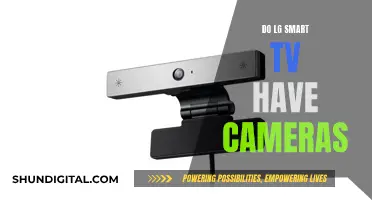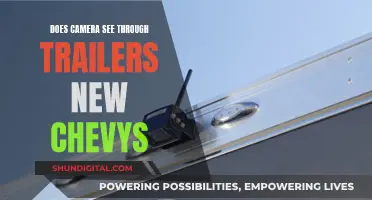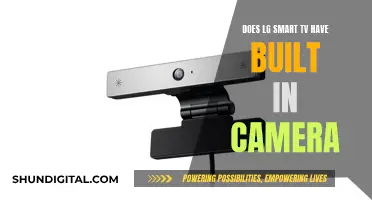
TV cameras are still huge and expensive because of the equipment attached to them. The lens attached to the camera is extremely costly, making up the majority of the cost of the entire setup. The lens is so expensive because it covers a massive focal range, has a wide maximum aperture, is parfocal, is stable, and uses powerful but accurate motors for aperture, zoom, and focus control. The other equipment attached to the camera is also expensive, such as the tripod and fluid head, remote control handles, and camera-to-lens adapter. In addition, broadcast cameras need to be able to adapt to almost any environment, from talk shows to sports coverage, which requires expensive and specialized equipment.
| Characteristics | Values |
|---|---|
| Cost of the lens | $200,000+ |
| Focal range of the lens | 8.6-900mm (1800mm with built-in extender) |
| Maximum aperture of the lens | f/1.7 – f/4.5 (f/8 at 1800mm) |
| Tripod and fluid head | $20,000 |
| Remote control handles | $9,000 |
| Camera-to-lens adapter | $7,000 |
| Fibre optic transmission module | $3,000 |
| Cost of the camera | $3,000-$3,500 |
| Cost of the full setup | $250,000 |
| Flexibility and adaptability | Able to adapt to almost any environment |
| R&D costs | High due to small market size |
What You'll Learn

The camera lens is the most expensive component
The camera lens is the most expensive part of a TV camera setup. In one example, the lens makes up $212,000 of the $250,000 total cost of the setup. In another example, the lens is $200,000 out of a $250,000 total. This is because the lens has to be able to adapt to almost any environment, from talk shows to sports coverage.
A $200,000+ broadcast lens is the ultimate do-it-all lens. It covers a massive focal range, at a wide maximum aperture, is parfocal, is stable, and uses powerful but accurate motors for aperture, zoom, and focus control. The Fujinon UA107 lens, for example, covers 8.6-900mm (1800mm with the built-in extender) at a maximum aperture of f/1.7 – f/4.5 (f/8 at 1800mm). It also has a built-in 2x teleconverter.
Lenses used for broadcast TV are so expensive because they make absolutely no compromises. They are packed with features, such as built-in image stabilisation and the ability to go from minimum to maximum range very quickly. They are also parfocal, meaning there is no need to refocus the shot as you zoom in and out, which is vital for live broadcasts.
The cost of broadcast camera lenses is also driven up by the fact that they exist in a very vertical market. There is not much competition, and there are not many sales, so R&D costs have to be recovered from a small number of purchases.
Attaching the PlayStation Camera: TV Mounting Guide
You may want to see also

The camera must adapt to the environment
In traditional video setups, the environment adapts to the camera. In broadcast, it's the other way around. The camera must be able to adapt to any environment it finds itself in. This could mean everything from talk shows to sports coverage.
The camera must be able to capture a wide range of shots, from wide-angle to extreme close-up, and it must be able to do this smoothly and seamlessly. This requires a large and expensive lens that can cover a massive focal range and has a wide maximum aperture. The lens must also be parfocal, meaning that there is no need to refocus as the camera zooms in and out, which is vital for live broadcasts.
In addition to the lens, the camera setup may also include a tripod and fluid head, remote control handles, a camera-to-lens adapter, and a fiber optic transmission module. These components add to the overall cost and bulk of the setup.
The camera must also be able to produce high-quality images in a variety of lighting conditions. This requires a camera with a high dynamic range and low light performance. It must also be able to handle a wide range of colours and skin tones accurately.
The camera must also be robust and reliable, able to withstand long hours of use and varying environmental conditions. It must also be easy to operate, with smooth and precise controls, as it will often be used by a professional camera operator.
All of these factors contribute to the high cost and large size of broadcast camera setups. The camera must be able to adapt to the environment, and this adaptability comes at a price.
Hooking Up a DVR to a Camera and TV: A Guide
You may want to see also

Leading-edge technology is costly
TV cameras are still huge and expensive because they are leading-edge products with a limited market. The technology is costly, and there are only a few thousand units sold, so the R&D costs are high for each unit.
The camera lens is the most expensive part of the setup, making up the majority of the cost and weight of a broadcast setup. A high-quality broadcast lens is extremely versatile and can cover a massive focal range with a wide maximum aperture. It is parfocal, stable, and uses powerful yet accurate motors for aperture, zoom, and focus control. The lens shown in the video, a Fujinon UA107, covers 8.6-900mm (1800mm with the built-in extender) at a maximum aperture of f/1.7 – f/4.5 (f/8 at 1800mm).
The other components of a broadcast setup are also expensive, including the tripod and fluid head, remote control handles, camera-to-lens adapter, and fiber optic transmission module. These parts ensure smooth and stable camera operation and the ability to adapt to different environments, which is crucial for live TV broadcasts.
In addition, TV cameras have to adapt to a wide range of environments, from talk shows to sports coverage. This versatility requires a significant amount of equipment and features, which adds to the overall cost. The camera has to be able to capture clear and stable footage in any lighting condition, and the optics and image sensors must be of the highest quality to ensure a crisp and vibrant image.
Furthermore, the extreme zoom range and associated hardware for steady video are necessary for broadcast work. Unlike traditional filmmaking, where the director can place the camera as needed, broadcast cameras need to be able to capture a wide area and quickly adjust to different shots, which requires more specialized and costly equipment.
Watching an Eclipse: Camera Screen Projection
You may want to see also

Vertical market means fewer sales to cover R&D
TV cameras are expensive due to the small vertical market in which they operate. This means that there are fewer sales to cover the costs of R&D (research and development). The R&D costs for broadcast camera systems are high because they are leading-edge products with cutting-edge technology. The technology is expensive, and the number of units sold is relatively small. Therefore, the R&D costs have to be spread across a small number of units, which significantly impacts the unit cost.
The vertical market for TV cameras is small because they are highly specialised pieces of equipment. They are designed to be adaptable to almost any environment, from talk shows to sports coverage. This adaptability comes at a high cost, and the equipment is therefore very expensive.
The cost of TV cameras is also driven up by the extras that are bolted onto the camera, such as the lens, tripod, remote control handles, and fibre optic transmission module. These extras can add tens of thousands of dollars to the overall cost of the setup.
The optics and lens system of a TV camera are particularly expensive. The lenses are large and feature-rich, with a massive focal range, wide maximum aperture, parfocal capabilities, image stabilisation, and powerful-but-accurate motors for aperture, zoom, and focus control. The cost of the lens can be over $200,000, which is a significant proportion of the total cost of the setup.
In addition to the high costs of the equipment itself, there are also the costs associated with operating and maintaining the equipment. TV cameras are often used for long periods of time without a break, which can lead to increased costs for recharging, swapping SD cards, and cooling the CMOS sensor. The lenses may also require regular cleaning due to environmental dust or moisture.
A Guide to Operating Spy Watch Cameras
You may want to see also

Broadcast cameras are more durable
While the camera itself is not huge, the broadcast setup as a whole is bulky and costly. The bulk of the weight and cost are contributed by the massive lenses used in these setups. These lenses are extremely versatile and are designed to make no compromises. They cover a massive focal range, have a wide maximum aperture, are parfocal, stable, and use powerful motors for aperture, zoom, and focus control. The Fujinon UA107 lens, for instance, covers 8.6-900mm (1800mm with the built-in extender) and has a maximum aperture of f/1.7 – f/4.5 (f/8 at 1800mm).
In addition to the lens, other components of a broadcast setup contribute to its overall durability. These include the tripod and fluid head, remote control handles, camera-to-lens adapter, and fiber optic transmission module. These components facilitate smooth and stable camera movements, enable remote operation, and ensure reliable data transmission.
The durability of broadcast cameras is further enhanced by their ability to adapt to various environments and shooting conditions. They can be used for everything from talk shows to sports coverage, eliminating the need for specialized gear for different scenarios. This adaptability comes at a cost, both in terms of size and expense.
Moreover, broadcast camera systems are often at the forefront of technology, incorporating leading-edge innovations. The relatively limited market for these cameras, primarily broadcast television, means that the high development and manufacturing costs are spread across a smaller number of units sold. This dynamic further contributes to the overall expense of these systems.
In summary, the durability and versatility of broadcast cameras come at a cost. The lenses and associated equipment are designed to meet the demanding requirements of broadcast television, resulting in bulkier and more expensive setups compared to other types of camera systems.
Are Gas Stations Closely Monitoring You?
You may want to see also
Frequently asked questions
The majority of the cost of a broadcast setup comes from the massive lenses that are used. In one setup, the lens makes up $212,000 of the approximately $250,000 total price tag.
A $200,000+ broadcast lens is the ultimate do-it-all lens: it covers a massive focal range, at a wide maximum aperture, is parfocal, is stable, and uses powerful-but-accurate motors for aperture, zoom, and focus control.
Other expensive components include the tripod and fluid head ($20,000), remote control handles ($9,000), camera-to-lens adapter ($7,000), and fiber optic transmission module ($3,000).
In broadcast, the camera needs to adapt to the environment, which requires a lot of additional features and equipment. This results in a much larger setup compared to traditional video setups, where the environment is adapted to the camera.







